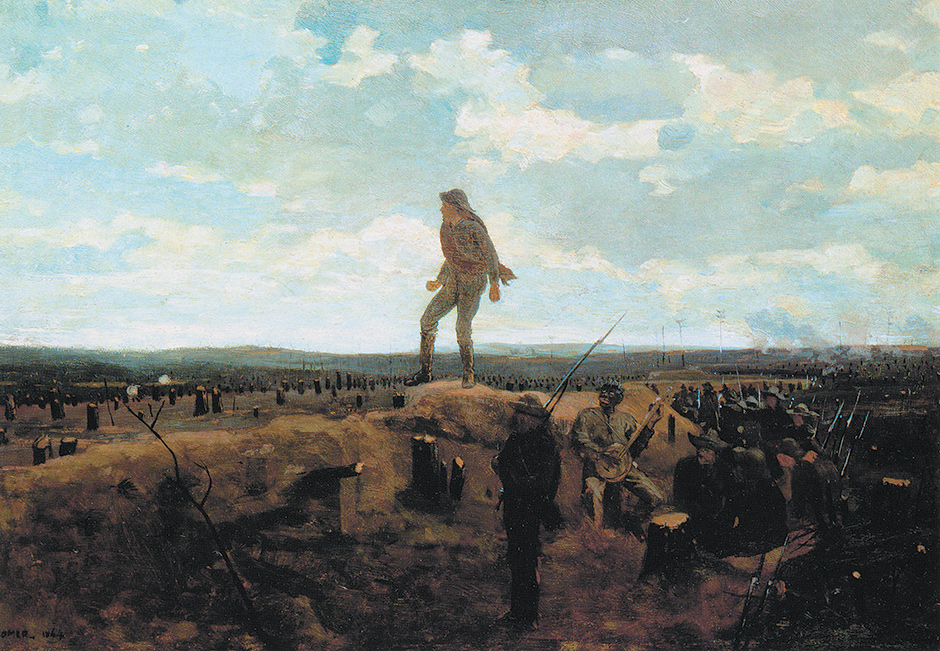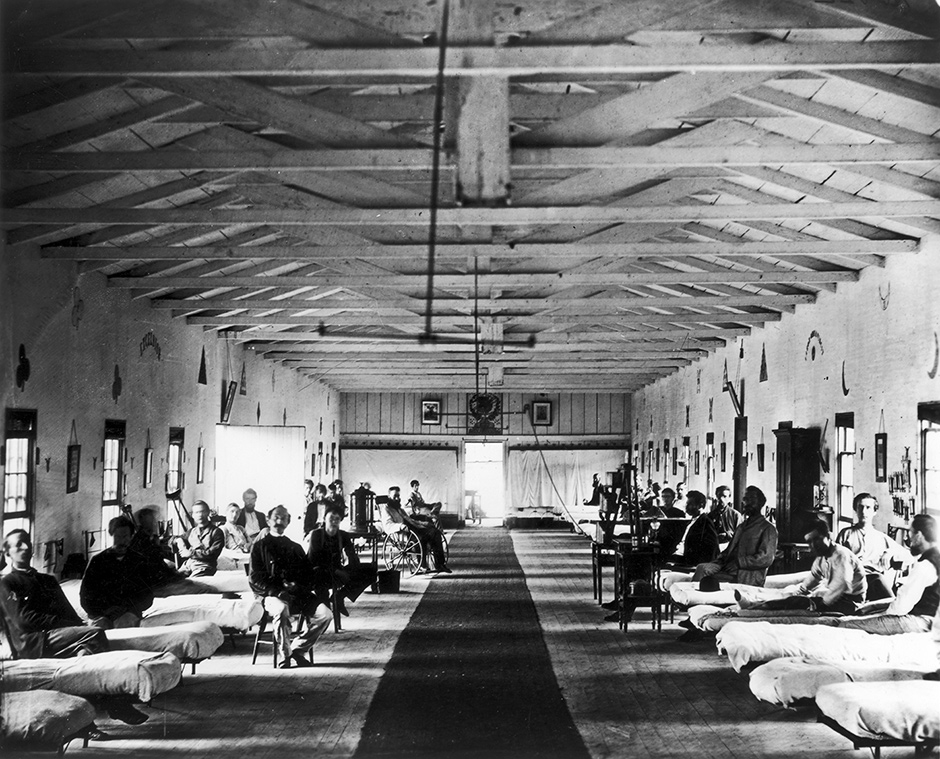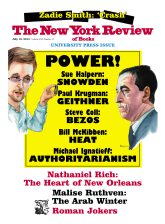Living Hell is an extended antiwar sermon. Like all good preachers, Michael C.C. Adams begins with a quoted text, this one from a speech in 1880 by General William T. Sherman to an audience in which many of the listeners were too young to remember the trauma and devastation of the Civil War. “There is many a boy here to-day who looks on war as all glory,” said Sherman, “but, boys, it is all hell.”
Growing up in Britain in the 1960s, during the centennial commemorations of the American Civil War, Adams “harbored romantic notions of dramatic exploits on the battlefield, of boys being forged into men through the ultimate test of combat.” But as he grew older, moved to the United States, and became a professional historian teaching at the University of Northern Kentucky, he learned about the dark side of the Civil War with its “pain, heartbreak, and tragedy.” Living Hell is the result, and it paints a dark picture indeed.
Living Hell is not Adams’s first anti-war sermon. Twenty years ago he published a book with the sardonic title The Best War Ever: America and World War II. It challenged the notion of that conflict as a “good war” that brought Americans together, struck down evil tyrannies, and created a beneficent new world order under the leadership of the United States. “In fact,” wrote Adams,
combat in World War II was a horrible experience and left lasting physical and mental scars on many combatants…. Loss of personal freedom, sexual deprivation, physical misery, chronic exhaustion, and immersion in a chamber of horrors coalesced to produce strain beyond endurance.
As for bringing Americans together and saving the world,
the myth of national unity in World War II has blinded Americans to the continuing racism in US culture…. For many of the world’s population, including Americans, the Four Freedoms [of speech, of worship, from want, and from fear] were not realized: the poor still suffered want, and minorities and women still did not have full freedom.1
Living Hell presents an even grimmer picture of the Civil War. As a percentage of the population, the Civil War killed seven times as many American soldiers (Union and Confederate) as World War II. To illustrate the horrors of Civil War combat, Adams puts together a “virtual tour” of the firing line drawn from a pastiche of contemporary sources:
We watch Corporal James Quick stumble back as a bullet enters behind his left jaw and exits through the nose. He is just twenty-two. Next to him, Lieutenant William Taylor has been hit in the neck by a bullet that missed the arteries but severed his windpipe. He clasps his hands to his neck, trying to stanch the flow of blood and air hissing through the wound. Private Keils runs past, “breathing at his throat and the blood spattering” from a neck wound…. We avoid Private George Walker because his right arm is off, severing the artery, and blood “on certain movements of the arm, gushed out higher than his head.” Blood spurts, too, from a Federal officer shot behind the bridge of his nose; he wanders about, continuing to blink even though both eyes are gone, “opening and closing the sightless sockets, the blood leaping out in spouts.”
And so it goes on for several more pages.
One of the worst jobs of soldiering was burial detail after a battle. “Cadavers quickly swelled to twice their normal size,” writes Adams. “Gases distended stomachs that then burst, emitting foul and, to Victorians, deadly odors.” A Pennsylvania soldier ordered to bury the dead after the Battle of Gettysburg described corpses with faces “black as charcoal and bloated out of all human semblance; eyes, cheeks, forehead and nose all one level of putrid swelling…with here and there great blisters of putrid water, some the size of a man’s fist on face, neck and wrists.” Another soldier unlucky enough to draw burial duty at Gettysburg wrote years later that
I shall remember that day and its ghastly dead. We took them from perfect lines of battle as they had fallen; we dragged them out from behind rocks…with eyes and mouths distended, and faces blackened by mortification.
Disease was even more lethal than combat. Fetid water, poor and insufficient food, bad sanitation, clouds of flies and other insects, extremes of weather, and primitive medical knowledge caused dysentery, diarrhea, typhoid fever, pneumonia, malaria, and a host of other maladies that carried away twice as many soldiers as did the fighting. Lice and chiggers were ubiquitous; no soldier escaped the misery they caused. “Malnutrition and diarrhea gravely impaired the efficiency of armies,” declares Adams, “causing depression, lethargy, night blindness, muscular debility, neuralgia, and susceptibility to major diseases. Finally, emaciated men could not march or fight and died.”
Advertisement
Thousands of those who survived became psychiatric casualties, suffering from what amounted to post-traumatic stress disorder, unrecognized then but evident to us today when reading about the symptoms of soldiers who had gone “insane.” Captain Oliver Wendell Holmes Jr. wrote during the fighting in Virginia in 1864 that “many a man has gone crazy since this campaign began from the terrible pressure on mind & body.”
Adams devotes considerable attention to atrocities committed by soldiers of both sides. On several notorious occasions, Confederate soldiers murdered black Union soldiers after they had surrendered. A Texas officer wrote after a battle in Louisiana: “I never saw so many dead negroes in my life. We took no prisoners, except the white officers, fourteen in number; these were lined up and shot after the negroes were finished.” In retaliation, Union soldiers sometimes shot Confederate captives. Prisoners who survived the ordeal of capture and were taken to prison camps often fared little better. “Both sides treated their military captives appallingly,” Adams maintains. He notes that about 30,000 or 18 percent (actually it was 15.5 percent) of Union POWs died in enemy prison camps, and 26,000 or 12 percent of Confederate captives perished in Northern camps. “North and South practiced malignant neglect at best, callous inhumanity at worst.”
The guerrilla warfare that wracked parts of the South and the border states was especially vicious, sometimes featuring “the burning alive of enemy civilians thrown into flaming buildings, as well as random torturing and killings accompanied by grisly trophies, including ears, genitals, scalps.” Rape was a common crime “throughout all theaters of the conflict,” according to Adams, who takes issue with the majority of historians who have remarked on how little evidence there was of rape outside areas of internecine guerrilla conflict. Then as now, he suggests, most cases of rape were never reported, so the actual number of rapes was much greater than the evidence indicates. Moreover, inflation, shortages, malnutrition, and the breakdown of social order in large theaters of the war, mainly in the South, forced many women into prostitution.
In many ways the conflict was as hard on civilians as on soldiers. “Famine stalked in the wake of armies,” according to Adams. Soldiers on both sides plundered the property of Southern civilians, and by 1864 the leadership of the Union army turned this ancient infliction by armies into a deliberate policy to cripple the Confederacy’s ability to sustain the war by destroying the Southern infrastructure. “The South’s fierce intransigence and the North’s ruthless determination,” concludes Adams, “resulted in thousands upon thousands of civilians being beaten, starved, economically ruined, their mental and physical health destroyed.”
Most of these baneful consequences of the Civil War are familiar to historians, though none has written about them in such relentless and hyperbolic fashion as Adams. Were there any socially redeeming features to compensate for these obscenities of war? In his book on World War II, Adams acknowledged that the Nazis and Japanese militarists could have been stopped only by war and that overthrowing them was necessary.2 But he finds no such beneficial results of the Civil War.
Preservation of the United States as one nation, indivisible? Probably not worth it; “others around the world have wondered if the United States became too big and clumsy for its own or anyone else’s good.” Liberation of the South (and the nation) from the incubus of slavery? In 1865 the South “lay in ruins and would take about a century to recover.” Emancipation of four million slaves and their elevation to equal citizenship by the Thirteenth, Fourteenth, and Fifteenth Amendments to the Constitution? “We realize now that freeing the slaves without giving them an economic stake in society assured peonage.” By 1900, disfranchisement of black voters in the South, legalized segregation, lynching, and debt peonage imposed by the sharecropping system had reduced the freedpeople to a new and perhaps worse form of slavery. “Was the war in vain?” Adams quotes a black woman writing in 1902. “Has it not made our condition more hopeless?… We are burned, tortured, and denied a fair trial, murdered for any imaginary wrong conceived in the brain of the negro-hating white man.”
That this state of affairs resulted from failures of the postwar generation rather than of the war seems to escape notice. And while the state of race relations in 1900 was indeed deplorable, Adams might have found it worth mentioning that black children could no longer be sold away from their parents or wives from husbands as they had been in slavery. That the Fourteenth and Fifteenth Amendments were a direct result of the war, and have provided the constitutional basis for civil rights and voting rights legislation and court decisions during the past sixty years, also finds no place in Adams’s account.
Advertisement
The book is marred by a good many other omissions and errors. Not surprisingly, perhaps, several of these tend to reinforce the negative portrayal of the war. It is true, as Adams notes, that black Union soldiers initially received less pay than white soldiers. But he fails to point out that this discrimination was removed in June 1864 and that nearly all black soldiers eventually received full remedial back pay for the months of inferior compensation.
It is also true that the mortality rate of Union captives in Confederate prison camps was appalling. The 12 percent of Confederates who died in Union prisons also seems shocking, but we do not learn from Adams that this mortality rate was considerably less than the 20 percent of Confederate soldiers who died of disease in their own army. Adams claims that the demobilization of the army (he apparently means only the Union army) in 1865 created “a flood of one million unemployed.” Read literally, this would seem to mean that every one of the million demobilized Union veterans was unemployed. But that is absurd; nearly half of them went back to their family farms, and most of the rest quickly found work. There may have been a temporary uptick of unemployment after the war, but nothing like a “flood.”
Adams portrays the soldiers who enlisted in 1861 as young, innocent, and enthusiastic, with no idea of what hardships and disillusionment lay ahead of them. “Boys in their late teens comprised the largest category of soldiers, at 40 to 50 percent of the whole. About 250,000 were just entering their teen years.” Where he got this information is not clear, but it could not be more wrong. Of a sample of just over a million Union soldiers (about half of the total for the war), 127 were recorded as age thirteen when they enlisted—drummer boys and musicians. The median age at time of enlistment was twenty-three and a half. Rather than 40 to 50 percent of the whole, soldiers of all teenage years through age nineteen made up about 23 percent of the total.3
In his discussion of discrimination against black soldiers in the Union army, Adams describes the black division that attacked at the infamous Crater in Petersburg on July 30, 1864, as a “‘forlorn hope,’ thrown foremost into the assault and sustaining massive casualties.” They did suffer a large number of casualties, to be sure, but they were not “thrown foremost into the assault.” They went in last, behind three white divisions. They had trained for weeks to spearhead the attack, but at the last moment Generals George G. Meade and Ulysses S. Grant ordered the white divisions to go in first.
Grant later explained that if black troops had led the assault and the battle turned out badly (as in fact it did), it would have been said “that we were shoving those people ahead to get killed because we did not care anything about them. But that could not be said if we put white troops in front.”4 Grant could not anticipate that Adams would make the precise accusation that he took care to forestall.
Enlisted soldiers who could not take it anymore could get out of the army only by deserting. But officers could resign without stigma—a form of class discrimination, according to Adams. As an example, he cites Captain Oliver Wendell Holmes Jr., wounded three times, who could stand no more, refused promotion, and resigned in 1864. It is true that Holmes had refused promotion to lieutenant colonel in the 20th Massachusetts Infantry, in which he had served for the previous two and a half years, in favor of a safer staff position—not surprising, perhaps, since he had suffered two life-threatening wounds as a line officer. As it turned out, he narrowly escaped capture as a staff officer in May 1864. In any event, he told his parents that month that “I have made up my mind to stay on the staff if possible till the end of the campaign & then if I am alive, I shall resign.”5 This letter apparently misled Adams to the conclusion that Holmes did resign. It also misled Holmes’s father, who questioned his intention, prompting an aggrieved letter from the captain:
I am sure I cannot have conveyed the idea, rightfully, that I intended resigning before the campaign was over…. I must say I dislike such a misunderstanding, so discreditable to my feeling of soldierly honor.6
Holmes did not resign; he served out the full three years of his enlistment, and returned home with honor in July 1864.7
Adams also has a muddled understanding of the Fourteenth and Fifteenth Amendments to the Constitution. The Fourteenth, he writes, “seemingly gave the franchise to all citizens.” It did nothing of the kind; it was the Fifteenth Amendment that dealt with the franchise, and it did not enfranchise all citizens, but rather prohibited states from denying the right to vote on grounds of race, color, or previous condition of servitude. After Susan B. Anthony tried to vote in 1872, the Supreme Court upheld her fine for illegal voting. By this decision, writes Adams, “the Court overrode the US Constitution,” another example of the dismal aftermath of the Civil War. But neither the Fourteenth nor Fifteenth Amendment had anything to do with women’s suffrage, and the Supreme Court certainly did not override the Constitution in this case. The Fourteenth Amendment did confer citizenship on all persons, including women, blacks, and children of immigrants born in the United States, a landmark achievement of the Civil War era that continues to resonate powerfully today, but goes unremarked by Adams.
This book has made an important contribution to the field of Civil War studies by reminding us graphically of the war’s dark side. But Adams’s jeremiad could have made a greater contribution if he had paid more attention to some of the facts and allowed an occasional ray of light to penetrate the darkness.
-
1
Michael C.C. Adams, The Best War Ever: America and World War II (Johns Hopkins University Press, 1994), pp. xiv, 112, 148, 137. ↩
-
2
Adams, The Best War Ever, p. xiii. ↩
-
3
Benjamin A. Gould, Investigations in the Military and Anthropological Statistics of American Soldiers (US Sanitary Commission, 1869), pp. 34–35. ↩
-
4
Report of the Committee on the Conduct of the War on the Attack on Petersburg, on the 30th Day of July, 1864 (Government Printing Office, 1865), p. 5. ↩
-
5
Holmes to his parents, May 16, 1864, in Touched With Fire: Civil War Letters and Diary of Oliver Wendell Holmes, Jr., 1861–1864, edited by Mark De Wolfe Howe (Harvard University Press, 1946), p. 122. ↩
-
6
Holmes to his parents, May 30, 1864, in Touched With Fire, p. 135. ↩
-
7
Touched With Fire, pp. 151–152. ↩





